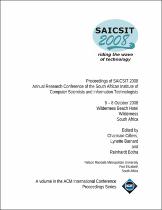 ResearchSpace
ResearchSpace
Designing technology for young children: what we can learn from theories of cognitive development
JavaScript is disabled for your browser. Some features of this site may not work without it.
- ResearchSpace
- →
- Research Publications/Outputs
- →
- Conference Publications
- →
- View Item
| dc.contributor.author |
Gelderblom, H

|
|
| dc.contributor.author |
Kotzé, Paula

|
|
| dc.date.accessioned | 2008-11-12T08:33:26Z | |
| dc.date.available | 2008-11-12T08:33:26Z | |
| dc.date.issued | 2008-10 | |
| dc.identifier.citation | Gelderblom, H and Kotze, P. 2008. Designing technology for young children: what we can learn from theories of cognitive development. South African Institute of Computer Scientists and Information Technologists (SAICSIT) 2008 Conference: Riding the wave of technology. Wilderness, South Africa, 6-8 October 2008, pp 16 | en |
| dc.identifier.isbn | 978-1-60558-286-3 | |
| dc.identifier.uri | http://hdl.handle.net/10204/2514 | |
| dc.description | Copyright: 2008 ACM | en |
| dc.description.abstract | The majority of guidelines and principles for design of technology are aimed at products for adults. The limited guidelines available for design of young children’s technology do not focus sufficiently on age-related requirements or they offer high-level advice that is only useful in the planning stages of design. This paper reports on research aiming to develop a set of guidelines for the design of technology for children aged five to eight years. The authors believe that the existing knowledge base on child development provides an ample starting point for setting up a useful framework of such guidelines. This paper demonstrates how the knowledge contained in psychological theories of child development can be translated into guidelines for the design of technology | en |
| dc.description.sponsorship | South African Institute of Computer Scientists and Information Technologists | en |
| dc.language.iso | en | en |
| dc.publisher | South African Institute of Computer Scientists and Information Technologists (SAICSIT) | en |
| dc.subject | Children's technology | en |
| dc.subject | Child development | en |
| dc.subject | Cognitive development | en |
| dc.title | Designing technology for young children: what we can learn from theories of cognitive development | en |
| dc.type | Conference Presentation | en |
| dc.identifier.apacitation | Gelderblom, H., & Kotzé, P. (2008). Designing technology for young children: what we can learn from theories of cognitive development. South African Institute of Computer Scientists and Information Technologists (SAICSIT). http://hdl.handle.net/10204/2514 | en_ZA |
| dc.identifier.chicagocitation | Gelderblom, H, and Paula Kotzé. "Designing technology for young children: what we can learn from theories of cognitive development." (2008): http://hdl.handle.net/10204/2514 | en_ZA |
| dc.identifier.vancouvercitation | Gelderblom H, Kotzé P, Designing technology for young children: what we can learn from theories of cognitive development; South African Institute of Computer Scientists and Information Technologists (SAICSIT); 2008. http://hdl.handle.net/10204/2514 . | en_ZA |
| dc.identifier.ris | TY - Conference Presentation AU - Gelderblom, H AU - Kotzé, Paula AB - The majority of guidelines and principles for design of technology are aimed at products for adults. The limited guidelines available for design of young children’s technology do not focus sufficiently on age-related requirements or they offer high-level advice that is only useful in the planning stages of design. This paper reports on research aiming to develop a set of guidelines for the design of technology for children aged five to eight years. The authors believe that the existing knowledge base on child development provides an ample starting point for setting up a useful framework of such guidelines. This paper demonstrates how the knowledge contained in psychological theories of child development can be translated into guidelines for the design of technology DA - 2008-10 DB - ResearchSpace DP - CSIR KW - Children's technology KW - Child development KW - Cognitive development LK - https://researchspace.csir.co.za PY - 2008 SM - 978-1-60558-286-3 T1 - Designing technology for young children: what we can learn from theories of cognitive development TI - Designing technology for young children: what we can learn from theories of cognitive development UR - http://hdl.handle.net/10204/2514 ER - | en_ZA |





